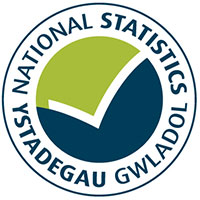Provides a summary of sensory care services offered to people with poor eye health and hearing loss for April 2017 to March 2019.
This is not the latest release in the series: Sensory health (eye care and hearing statistics)
Series information:
Sight loss
- The National Survey for Wales for 2018-19 asked how often respondents’ had their eyes tested. 73% of adults aged 16 or over reported that they have their eyes tested at least once every two years.
Primary eye care services
- During 2018-19, 795,188 General Ophthalmic Service sight tests were paid for by the NHS, a 0.6% increase on the previous year.
- 184,366 examinations were carried out under Eye Health Examinations Wales during the same year.
- Of the 114,309 patients screened (with results reported) by the Diabetic Eye Screening Wales Service in 2017-18, 28.9% were found to have some degree of diabetic retinopathy (a small number were ungradeable).
Hospital eye services
- There were 322,744 attendances to ophthalmology outpatient appointments in Welsh hospitals in 2017-18.
- Health Boards received 107,448 referrals for ophthalmology in 2018-19, of which 33,357 were from GPs.
Rehabilitation
Low Vision Service
- 9,183 assessments were carried out by the Low Vision Service Wales.
People newly certified and/or registered as severely sight impaired and sight impaired
- At 31 March 2018, over 15,000 people were registered with a visual impairment, of whom around half were registered as severely sight impaired and half as sight impaired.
- 1,455 people were newly certified as sight impaired in 2017-18; over 52% of these were aged 80 years or over.
Workforce
- There were 875 practitioners carrying out sight tests paid for by the NHS at 31 December 2018, 34 more than in the previous year and a 19.2% increase since December 2008.
- At 30 September 2018 there were 133.9 whole time equivalent ophthalmology doctors directly employed by the NHS in Wales.
Hearing
- National Survey Wales recorded that 19% of adults reported having difficulty with their hearing in 2018-19.
- At 31 March 2019, no patients had been waiting for a hearing aid for more than the target 14 weeks.
- At 30 September 2018 there were 117.0 whole time equivalent otolaryngology doctors directly employed by the NHS in Wales.
Reports

Sensory health: eye care and hearing statistics, April 2017 to March 2019 - Revised , file type: PDF, file size: 4 MB
PDF
4 MB
If you need a more accessible version of this document please email digital@gov.wales. Please tell us the format you need. If you use assistive technology please tell us what this is.
Data
Datasets and interactive tools
Sensory health: eye care and hearing statistics, April 2017 to March 2019: Annex tables - Revised , file type: ODS, file size: 332 KB
ODS
332 KB
If you need a more accessible version of this document please email digital@gov.wales. Please tell us the format you need. If you use assistive technology please tell us what this is.
Sensory health: eye care and hearing statistics, April 2017 to March 2019: dashboard , file type: ODS, file size: 746 KB
ODS
746 KB
If you need a more accessible version of this document please email digital@gov.wales. Please tell us the format you need. If you use assistive technology please tell us what this is.
Contact
Rhys Strafford
Telephone: 0300 025 0058
Email: stats.healthinfo@gov.wales
Rydym yn croesawu galwadau a gohebiaeth yn Gymraeg / We welcome calls and correspondence in Welsh.

